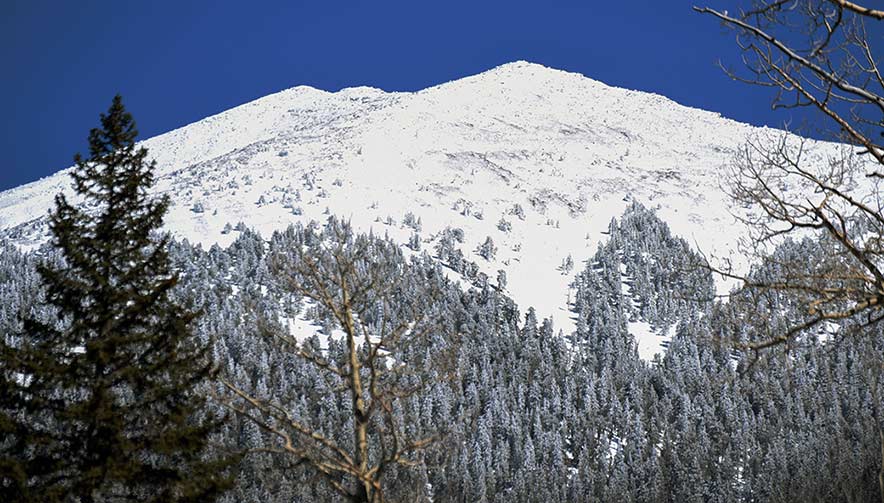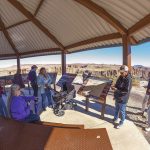
Where the diyinii live: Group opposes new development at ski area on Dook’o’sliid

Special to the Times | Krista Allen
The San Francisco Peaks, Dook'o'oosłííd, are covered with snow Feb. 18, 2021, in Kinłání.
By Krista Allen
Special to the Times
DOOK’O’OOSŁÍÍD-KINŁÁNÍ, Ariz.
The Arizona Snowbowl on Dook’o’oosłííd is one of the best ski destinations in the Southwest. But the mountain, with plentiful t’iisbáí and eye-catching vistas, is much more than that to at least 13 Native American tribes.
To those tribes, including the Báyóodzin, Diné, Dziłghą́’á and the Kiis’áanii, Dook’o’oosłííd is sacred. It holds the Diné constitution, it is part of the Diné identity, and it is where the diyinii live.
With opposition from the tribes, conservationists and some Tooh Dine’é locals, the resort has been in debate for decades. At stake is more than simply protecting the mountain from Snowbowl development and the resort’s use of reclaimed wastewater to make artificial snow.
The greater issue is not only protecting the delicate ecosystem that supports rare and isolated flora and fauna but also protecting tribes.
Shawn Mulford, along with Bucky Preston from Hopi, Dianna Uqualla from Havasupai, and a list of others, asked U.S. Rep. Tom O’Halleran on March 8 to hold congressional field hearings to examine Snowbowl’s compliance with federal laws and regulations and with the U.S. Forest Service.
Mulford, a Diné who’s a longtime Dook’o’oosłííd advocate and a researcher, and the group want the hearings conducted jointly with the House Committee on Natural Resources, which is chaired by U.S. Rep. Raúl M. Grijalva, D-Ariz.
The group also is concerned about the historical, spiritual, social, environmental, and the legal dimensions of Snowbowl’s proposal, saying congressional oversight is necessary because of a long history in which a private business built on public land has been allowed to push aside and harm the relationships between the tribes, the mountain, and the living beings on the mountain.
This involves desecration and trauma of not only the plants and the animals but also of Native people and the communities they come from, the group said.
New master plan
J.R. Murray, the chief planning officer for Snowbowl, released information in June 2019 – when he was the general manager – detailing the resort’s latest master plan.
Murray at that time said Snowbowl was intending to file the new master plan proposal that summer and would invest $60 million in upgrades including new lifts, night skiing and snowboarding and new facilities.
The plans included expanding the services offered to visitors without adding an acre to the Forest Service permitted land within Snowbowl’s 777-acre resort.
He added that the expansion would not require a new agreement for more water from the city of Flagstaff.
As Snowbowl leases its land from the Forest Service the resort needs to submit a new master plan to guide development on Dook’o’oosłííd. The 2005 plan included snowmaking from reclaimed wastewater.
Murray told the Navajo Times that Snowbowl will continue to use reclaimed water for snowmaking with no modification.
“More people would oppose using potable water for snowmaking,” Murray said. “The reclaimed water meets or exceeds all state and federal guidelines and poses no health risks.”
Murray said after Snowbowl became the first ski resort in the U.S. to use reclaimed water, five other ski resorts followed and more are researching the prospect.
“A few projects remain from the 2005 master development plan,” said Robert Linde, the general manager for Snowbowl, “including replacement of the Aspen chairlift, lodge space at both Agassiz and Hart Prairie base areas, a hiking trail, and snowmaking on existing ski trails.”
Linde said Snowbowl has been working on a new master development plan with the Coconino National Forest for the past two years and that the new plan’s projects will follow the National Environmental Policy Act process before any approval is granted.
“There will not be projects planned, approved or implemented that expand the current special use permit boundary,” Linde explained. “All proposed projects are within the existing ski area boundary. All projects are reviewed and approved by the Coconino National Forest prior to any implementation.”
Linde said the NEPA Process will be used for analyzing the new master development plan and formal consultations with local tribes will also occur.
Mountain activists have stated that Snowbowl is violating the Arizona Department of Environmental Quality’s prohibition (Section R18-9-B702) of stormwater mixing with reclaimed water.
Linde said Snowbowl operates in compliance with ADEQ regulations as the ski resort is inspected regularly for compliance since 2012 with no violations.
End impunity
The Indigenous Circle of Flagstaff, an intertribal grassroots organization, is calling for change in the wake of Snowbowl’s new master development plan.
ICF started a change.org petition to O’Halleran, Interior Secretary Deb Haaland, Coconino National Forest Supervisor Laura Jo West, and four others, including U.S. senators Mark Kelly and Kyrsten Sinema, both Democrats for Arizona.
The petition, calling to end “impunity” for Snowbowl, amassed more than 53,000 signatures of a 75,000 goal. It also describes the Forest Service’s 2005 analysis of the ski resort.
“Since then, Snowbowl has made numerous modifications to its operations – some without any environmental review, public involvement, or tribal consultation,” the petition reads. “Aerial photographs reveal Snowbowl’s construction of a new parking lot in an area known as Hart Prairie, which will rapidly expand its business to a year-round model.
“In 2005, the Coconino National Forest refused to even discuss allowing an increase in daily visitation above 2,825 skiers per day,” the petition says, “insisting that they would keep parking capacity static to prevent an increase in visitors.”
Linde said Snowbowl has worked closely with the Forest Service – and with the Coconino County Health Department especially during COVID – to develop the ski resort’s operational guidelines.
Linde added that the main objective right now is to remain open and to provide an outdoor recreational experience during these challenging times.
Activists say lot construction causes severe environmental degradation and erosion of a formerly intact meadow ecosystem, and it is being constructed without public notice, comment and review procedures, and without Indigenous consultation.
Murray said the Snowbowl team has traveled to tribal communities and villages for decades and did outreach to all 13 tribes.
And when COVID-19 entered the U.S., only two tribes could not meet with Snowbowl.
“Some tribal members make clear the opposition to the ski area being (on Dook’o’oosłííd),” Murray said. “The experience going to (communities, villages) and tribal offices is unique and very educational. They appreciate the direct contact and ability to share their viewpoints. Each visit provides an opportunity to build relationships and understanding.”
The petition states, “Snowbowl’s desire for profit is threatening biodiversity, groundwater safety, and human communities that have been developing here for millennia … We are calling on Rep. O’Halleran to direct the Forest Service to end Snowbowl’s impunity.”
O’Halleran committed to meeting with ICF and groups in person at the end of the month to work toward a field hearing.








 Highway 264,
Highway 264, I-40, WB @ Winslow
I-40, WB @ Winslow